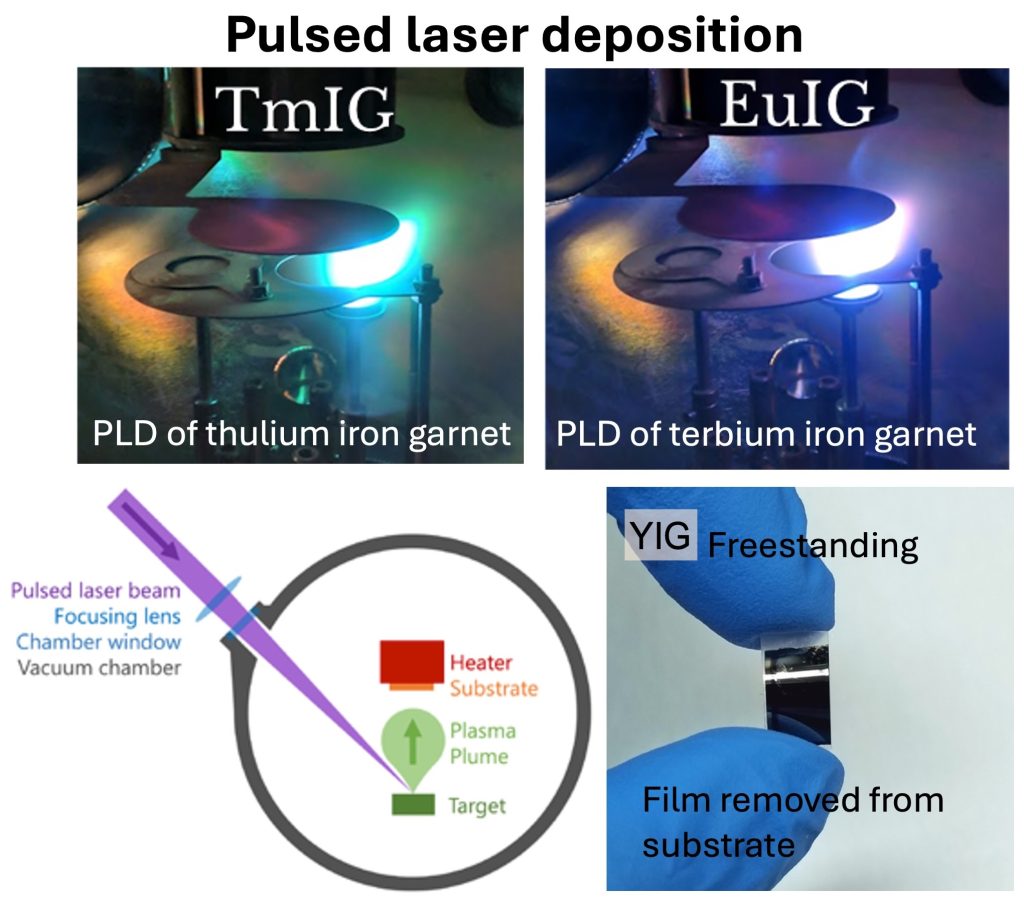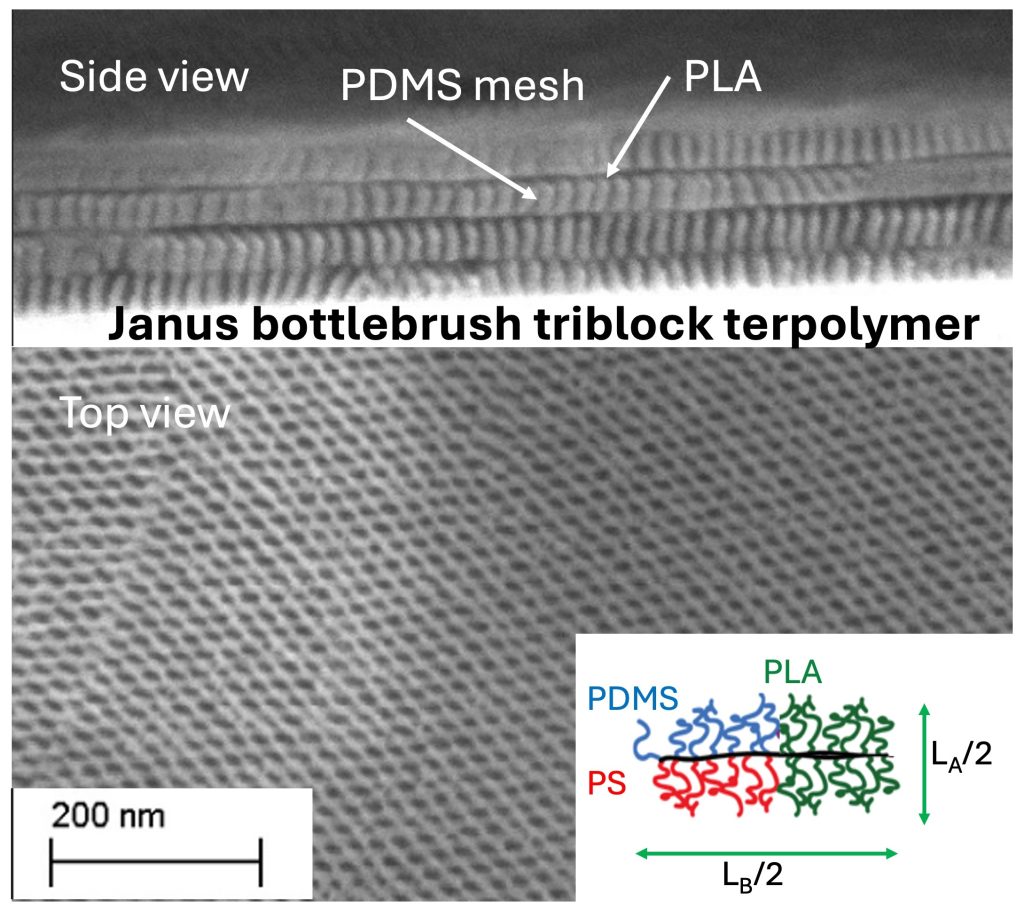Multiferroic and Ferroelectric Oxides and Nanocomposites
Pulsed laser deposition
Much of our research involves thin films of oxide materials made using PLD. A laser is used to evaporate material from a target and the material is deposited onto a substrate which can be heated up to ~1000 ˚ C. Deposition takes place in an oxygen environment or in vacuum. By using more than one target, thin films consisting of solid solutions, multilayers, or mixtures of materials can be grown. Our materials include garnets, perovskites, spinels and other oxides, which can be single crystal or polycrystalline. We are also developing methods to remove the films from the substrate.

Ferroelectricity in orthoferrites
Orthoferrites are oxides with composition RFeO3, where R is Y, Bi or a rare earth, with an orthorhombic structure derived from a distorted perovskite. In bulk, orthoferrites are canted antiferromagnets, but their crystal structure is centrosymmetric which prevents them from being ferroelectric. However, we found that thin films of orthoferrites can be ferroelectric if they have a non-ideal stoichiometry. In YFeO3 or LuFeO3, excess Y or Lu occupying Fe sites leads to a distortion of the crystal structure and a ferroelectric response. The material is therefore multiferroic, possessing both magnetic order and ferroelectricity. We are exploring whether this defect-mediated ferroelectricity is a general mechanism that could extend to other materials types. We have also investigated exchange coupling between antiferromagnetic orthoferrites and magnetic perovskites, making exchanged-biased epitaxial heterostructures and multilayers.

Self-assembled oxide nanocomposites
Two-phase vertical oxide nanocomposites are epitaxial thin films consisting of two phases, for example pillars of a spinel embedded in a matrix of a perovskite grown on a perovskite substrate. A multiferroic nanocomposite can be formed if one phase is ferrimagnetic (such as cobalt ferrite, a spinel) and the other is ferroelectric (such as bismuth ferrite, a perovskite). When the two phases are coupled via interfacial strain transfer, the nanocomposite becomes magnetoelectric, i.e. the magnetization of the spinel depends on the applied electric field and the electric polarization of the perovskite depends on the applied magnetic field. We have investigated nanocomposites made of various materials, templated the phase separation to form a range of geometries of the pillar phase, and demonstrated magnetoelectric coupling between the two phases and magnetostatic coupling in the magnetic phase. We have made anisotropic nanocomposites with fin-shaped nanopillars on substrates with different crystal orientations. Recent work includes the formation of garnet-perovskite composite films. Such precisely ordered multiferroic structures could be useful in electrically-operated magnetic memory or logic devices.

Magnetic and Magnetooptical Garnets
Rare earth and bismuth garnets for spintronics
We exploit the tunability of iron garnets, a class of ferrimagnetic complex oxides, to demonstrate anisotropy control, spin orbit torque switching, fast domain wall dynamics and interface phenomena. YIG (Y3Fe5O12) is the prototypical magnetic garnet, but replacing Y with a rare earth or Bi and replacing Fe with other cations such as Al, Ga or transition metals unlocks a vast range of properties. We use pulsed laser deposition to grow epitaxial films of garnet as thin as one unit cell, to synthesize garnet multilayers and heterostructures of garnets with other materials, and to integrate garnet onto Si and photonic devices.
We optimized the growth of ultrathin rare earth garnet films in which interfacial Dyaloshinskii-Moriya interactions are strong enough to stabilize homochiral domain walls, and demonstrated for the first time current-driven switching of a magnetic insulator, thulium iron garnet, via spin orbit torque from a current in an adjacent heavy metal layer. We grew strain-engineered Bi-substituted garnet (Bi-YIG) that combines perpendicular anisotropy with low damping, and showed spin orbit torque-driven domain wall velocities up to 4.3 km/s, approaching the magnon group velocity which leads to relativistic dynamics analogous to those of a particle approaching the speed of light. We demonstrated ultrafast translation of domain walls in Bi-YIG driven by coherent magnons produced by an antenna. This switching process is orders of magnitude more efficient than prior work in metal films, providing a new driving mechanism for racetrack and magnonic devices.

Cation ordering and multilayers of garnets
Thin films of garnets (and other oxides) can grow with cation site occupancy far from equilibrium due to epitaxial stabilization from the substrate, leading to properties not available in bulk garnets. For example, we showed that highly Tb-rich terbium iron garnet has a room temperature compensation temperature 80 K above that of bulk TbIG, and a Curie temperature 40 K below bulk. The temperature-dependent magnetism is understood using a newly-formulated molecular field coefficient model. We can introduce tunable perpendicular magnetic anisotropy (PMA) by strain engineering through growth of films on lattice mismatched substrates. We recently resolved a 50 year old question: explaining why garnet films with mixed rare earth species often show a growth-induced perpendicular anisotropy. By characterizing the atomic ordering of the rare earth ions using electron microscopy and x-ray diffraction, we showed that preferential occupancy of inequivalent sites by the rare earth ions leads to a reduction of symmetry and a large magnetic anisotropy. This provides the opportunity to control anisotropy and other properties without relying on strain.
Oxide superlattices reveal a rich array of emergent properties derived from the composition modulation and the resulting lattice distortion, charge transfer, and symmetry reduction that occurs at the interfaces between the layers. Most studies have focused on perovskite superlattices, but we made garnet superlattices such as (TmIG/TbIG) with layer thicknesses of half a unit cell in thickness, revealing properties that are qualitatively different from those of the intermixed solid solution.

Magnetooptical garnets and photonic devices
Iron garnets have excellent transparency and magnetooptical activity in the near-IR wavelength range used for optical communications. As a result, garnets have been used in isolators, optical devices that allow light to be transmitted in only one direction. To create isolators and other optical devices on a photonic integrated circuit, the device geometry has to be redesigned, and the magnetooptical materials must be grown as a thin film on a waveguide. We demonstrated a small footprint, monolithically integrated optical isolator based on magnetooptical Ce- or Bi-substituted YIG films cladding a silicon waveguide to provide the requisite non-reciprocal optical transmission. This device required development of both a synthesis route to form garnet films on Si, and a novel device design providing efficient optical isolation within a small device area. Subsequent device designs demonstrated the best reported isolation ratio and insertion loss of any integrated isolator, isolators that work for both transverse-electric as well as transverse-magnetic modes and for nitride waveguides, and isolators with broadband performance based on an interferometer design. We developed a range of garnets with Bi, Ce and Tb substitutions with high magnetooptical figure of merit. The integrated isolator provides a key advance in photonic integrated circuits.

Block Copolymer Self-Assembly
Block copolymer lithography
Block copolymer lithography takes advantage of the self-assembly of thin films of block copolymers to produce arrays of lines, dots and more complex features with periodicity of a few nm and above. The self-assembled patterns are then transferred into a magnetic or other material by etching, liftoff and other methods. We have focussed on block copolymers with a Si-containing block such as polystyrene-block-polydimethylsiloxane (PS-b-PDMS) which have an excellent etch contrast between the blocks, as well as using blocks such as polyvinylpyridine which can be functionalized with metal ions to make metallic nanostructures. We have explored various polymer architectures, including linear triblock terpolymers, star triblock terpolymers, rod-coil block copolymers, and bottlebrush copolymers to obtain a range of geometries that are not found in the simplest block copolymers. These include square symmetry patterns, zigzag patterns, and Archimedean tiling patterns. We have developed solvent annealing methods to induce the microphase segregation of the polymers, controlling the geometry of the microdomains by choice of solvent vapor composition and other annealing conditions, to produce a range of structures from a single block copolymer.

Directed self-assembly
Block copolymer self-assembly forms patterns with short range order, but we can use chemical or topographical templates to control the long range order of the pattern. We demonstrated the role of commensurability between the template dimensions and the block copolymer period, and developed sparsely-patterned templates, effectively multiplying the pattern density and speeding up the fabrication of nanostructures. We extended the capabilities of directed self assembly to form junctions, bends, spirals, concentric patterns and other structures not produced by the untemplated block copolymer. We showed how one block copolymer can template another to make meshes or aligned patterns. We created 3-dimensional structures such as cross-point arrays or cylinders which reorient from in-plane to out-of-plane directions. Self consistent field theory modeling and dissipative particle dynamics are used to predict and understand the behavior of the block copolymers. Applications for these structures include nanoscale electronic devices, metallization of integrated circuits, and membranes or filters.

Janus bottlebrush block copolymers
Bottlebrush copolymers consist of a backbone with sidechains of different chemistry. In a Janus bottlebrush block copolymer, the sidechains self-assemble on each side of the backbone so the period of the resulting structure is determined by the length of the sidechains rather than the length of the backbone as in a conventional bottlebrush block copolymer. We have explored Janus bottlebrush diblock and triblock copolymers, revealing structures that are not found in simple linear block copolymers such as perforated lamellar structures. Janus bottlebrush triblock copolymers are particularly interesting because they can form hierarchical structures with two different periods. Our (polystyrene-branch-polydimethylsiloxane)-block-poly(lactic acid) polymers formed a novel monoclinic mesh structure of PS-b-PDMS separated by larger period layers of PLA. Other interesting structures include cylinder-in-lamella and lamella-in-lamella, with periods of 20 – 60 nm. The hierarchical structures can also be guided using directed self-assembly, enabling 3-dimensional control. We are also studying brush-on-brush and other hierarchical molecular architectures to increase the range of self-assembled structures useful in nanofabrication.

